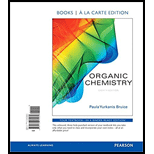
Concept explainers
(a)
Interpretation:
The value of
Concept introduction:
The amount of heat consumed or given off during the course of a reaction is known as enthalpy of reaction. Heat is given off when bonds are formed and heat is consumed when bonds are broken.
Heat is one form of energy.
The amount of energy required to break a
(b)
Interpretation:
The value of
Concept introduction:
The amount of heat consumed or given off during the course of a reaction is known as enthalpy of reaction. Heat is given off when bonds are formed and heat is consumed when bonds are broken.
Heat is one form of energy.
The amount of energy required to break a chemical bond is referred to as bond dissociation enthalpy.
(c)
Interpretation:
It should be identified that whether the given reactions (addition of HCl to ethene and addition of dihydrogen to ethene) are exothermic or endothermic in nature.
Concept introduction:
The amount of heat consumed or given off during the course of a reaction is known as enthalpy of reaction. Heat is given off when bonds are formed and heat is consumed when bonds are broken.
Heat is one form of energy.
The amount of energy required to break a chemical bond is referred to as bond dissociation enthalpy.
A reaction with a negative
A reaction with a positive
(d)
Interpretation: It should be identified that whether the given reactions (addition of HCl to ethene and addition of dihydrogen to ethene) are exergonic or endergonic in nature.
Concept introduction:
The amount of heat consumed or given off during the course of a reaction is known as enthalpy of reaction (H). Heat is given off when bonds are formed and heat is consumed when bonds are broken.
Heat is one form of energy.
The amount of energy required to break a chemical bond is referred to as bond dissociation enthalpy.
The mathematical relationship between enthalpy (H) and free energy (G) is,
In an exergonic reaction the products have a lower free energy than it consumes.
In an endergonic reaction the product have a higher free energy than it consumes.
Trending nowThis is a popular solution!

Chapter 5 Solutions
ORGANIC CHEMISTRY (LL)-W/MOD.MASTERING.
- Ff.203. what is meant by a hydrogenated oil? Why is this potentially dangerous to human health?arrow_forwardConversion of one molecule of H20 to 02 releases how many e- ? A. 2B. 4C. 8D. 6arrow_forwardDraw Lewis electron dot structures for CH3Cl (methyl chloride, a topical anesthetic), H2O2 (hydrogen peroxide, with an O-O bond), and NH2OH (with an N-O bond).arrow_forward
- The reaction 2 H2O(l) + O2(g) → 2 H2O2(l) has DeltaH = +200 kJ. Using this heat change and heat of formation of H2O(l), determine the heat change for the reaction H2O2(l) → H2(g) + O2(g). Heat of formatin (H2O) = -290 kJarrow_forwardWhat does Homogenous mean in everyday language to everyday people? Use examples to help describe your thoughts. How do people use the word? *(If there's any)* What does Homogenous mean in technical language to chemists? How is hemogenous related to: Quantify the behavior of acids and bases at the atomic level? What are the similarities and differences between the everyday and technical meanings and uses of Homogenous?arrow_forwardThe compound para-dichlorobenzene is the active ingredient of the bathroom deodorizer "Albatross". How many distinct products are possible for the reaction of para-dichlorobenzene with 1 equivalent of HNO3 in H2SO4? a. 3 b. 2 c. 1 d. 4 e. 5arrow_forward
- What is the heat of combustion of ethane, C2H6, in kilojoules per mole of ethane? Properties of C2H6 at 298K ∆Hf °kJ/mol = –84.0 ∆Gf°kJ/mol –32.0 S°J/(mol·K) = 229.2 Δ?∘rxn=___________kJ/mol ethanearrow_forwardGiven each of the following values, is the starting material or product lower in energy? a. ΔGo = 8.0 kJ/mol b.Keq = 10 c. ΔGo = −12 kJ/mol d.Keq = 10−3arrow_forward(a) Determine the product of the reaction ? + n (b) What is the Q value of the reaction?arrow_forward
- Consider the reactions below. In which cases is product formation favored by decreased temperature? 1) CO(g) + 3 H2(g) ⇌ CH4(g) + H2O(g); ΔHo = -206.2 kJ2) CO2(g) + C(s) ⇌ 2 CO(g); ΔHo = 172.5 kJ3) H2(g) + I2(g) ⇌2 HI(g); ΔHo = -9.4 kJ4) 3 O2(g) ⇌ 2 O3(g); ΔHo = 285 kJ5) 2 H2O(g) ⇌ 2 H2(g) + O2(g); ΔHo = 484.6 kJ Group of answer choices a.3, 5 b.1, 3 c.1, 4 d.2, 4, 5 e.1, 2, 5arrow_forwardWhat is friedel craft’s reaction? Give an example.arrow_forward2 NaHCO3(s) --> Na2CO3(s) + CO2(g) + H2O(g) (heat) above the arrow claasify the reactionarrow_forward
 Chemistry & Chemical ReactivityChemistryISBN:9781337399074Author:John C. Kotz, Paul M. Treichel, John Townsend, David TreichelPublisher:Cengage Learning
Chemistry & Chemical ReactivityChemistryISBN:9781337399074Author:John C. Kotz, Paul M. Treichel, John Townsend, David TreichelPublisher:Cengage Learning Chemistry & Chemical ReactivityChemistryISBN:9781133949640Author:John C. Kotz, Paul M. Treichel, John Townsend, David TreichelPublisher:Cengage Learning
Chemistry & Chemical ReactivityChemistryISBN:9781133949640Author:John C. Kotz, Paul M. Treichel, John Townsend, David TreichelPublisher:Cengage Learning Chemistry: The Molecular ScienceChemistryISBN:9781285199047Author:John W. Moore, Conrad L. StanitskiPublisher:Cengage Learning
Chemistry: The Molecular ScienceChemistryISBN:9781285199047Author:John W. Moore, Conrad L. StanitskiPublisher:Cengage Learning Introductory Chemistry: A FoundationChemistryISBN:9781337399425Author:Steven S. Zumdahl, Donald J. DeCostePublisher:Cengage Learning
Introductory Chemistry: A FoundationChemistryISBN:9781337399425Author:Steven S. Zumdahl, Donald J. DeCostePublisher:Cengage Learning



